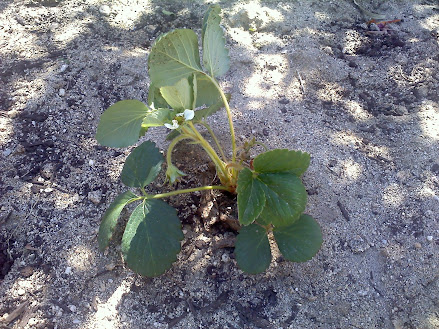If you live in the desert, you have coarse sand and you're probably wondering if anything will grow in your garden. Yes! With proper preparation and soil amendment, you too can grow a nice fruit and vegetable garden.
Step One: Tilling - If you currently do not have anything growing in the area you plan to start your garden, you have it easy, well... sort of. At least you don't have to worry about lawn, plant, or tree removal. A few growing weeds will be dispensed with in the following steps so they present no cause for concern. Unless they have flowers and have set to seed. If this is the case, we suggest you cut off the seed heads and throw them in the garbage before beginning the following garden prep process.
- To break up sandy soil and make the garden easier to work, and
allow room for roots to spread and take hold, I purchased a Hound Dog
Garden Steel Tiller

It requires elbow grease but it does a fantastic job. To make soil
tilling easier I ran the sprinklers right before beginning to till the
garden.
Step Two: Amending Soil
- Top Soil - Sandy soil requires amendments in order to help it retain moisture. This helps reduce water requirements and also helps sandy soil become more like organic gardening soil. Below is a picture of what the garden bed looks like right after tilling and shows the top soil that will be used to mix in with the sandy earth.

Each bag was opened and contents were even distributed on the garden bed. I then used a Hula Hoe to mix the top soil into the garden bed.

- Organic Fertilizer and Soil Amendment - In addition to needing top soil to help maintain moisture, organic matter is needed to amend soil and transform it more into garden soil. Since I choosing to have an organic garden, I chose to use Organic Garden Compost as a soil amendment. Below is a picture of the garden bed after Top Soil has been evenly distributed and worked into the garden bed, with the compost that I used.

I followed the same procedure used to distribute top soil. Below is a picture of the garden bed after the compost was distributed and worked into the garden bed.

Watering schedule, although there isn't anything in the garden bed yet, is running the sprinklers 10 minutes every three days. Although the garden bed is new, there are other areas throughout my property which requires watering, such as my lawn, rose and flower bed. We will see these areas in other posts. By watering the garden bed I am helping to encourage an optimum growing environment rich in organic matter and nutrients that will be primed and ready for my greenhouse transplants.It also give me the opportunity to see any left over weeds or seeds that begin to set root which I go back over with the hula hoe to get rid of before bringing in my greenhouse plants.
In my next post we will discuss fencing to keep the dogs out of my garden bed. Grrrrr!!!
